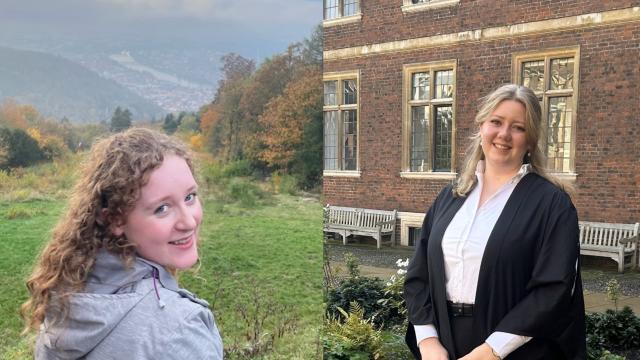
St Catharine's is committed to encouraging applications from academically strong students of all backgrounds. During the admission selection process itself, we take account of the levels of educational support and opportunity our applicants have had, with the aim of admitting those with the greatest academic potential.
There are three reasons why St Catharine’s strives to encourage applications from, and indeed offer places to, applicants from disadvantaged or disrupted backgrounds and applicants from under-represented groups.
1. A fair admissions system should be accessible to as wide a range of applicants as possible.
2. Cambridge prides itself on the academic quality of its students, and only by taking account of applicants’ previous academic experiences can we admit those with the greatest future academic potential.
3. St Catharine’s is committed to helping the University meet its access agreement with the Office for Students.
A large part of our access work hinges on the use of ‘contextual information’ during the admissions selection process. This webpage explains how we seek to use this information in a fair and effective way.
It is important to emphasise that St Catharine’s and the wider University believe that the best way to promote the admissions of applicants who have experienced educational disadvantage, and applicants from under-represented groups, is to encourage more such applicants to apply. Thus, receiving a large number of applications from candidates who may not have previously thought Cambridge was for them is the essential first stage in making our admissions system fair.
When do we use contextual information during the selection process?
There are several points during the admissions process when decisions are made about each application.
- when deciding whether to call for interview
- when deciding whether to make one of our interviewed applicants an offer of a place, or deciding to place them in the admissions pool for assessment by other colleges
- when deciding whether to make an offer to an applicant placed in the admissions pool by another college
- when the University makes additional 'open offers' in January to applicants who meet certain widening participation criteria; although these offer-holders are only guaranteed a place at the University, not a particular college, St Catharine's intends to admit all such open offer holders it 'underwrites' who achieve their conditional offer, provided it has sufficient accommodation to do so (to date, we have admitted all such successful offer-holders)
- when deciding whether to confirm the place of an applicant who has narrowly missed their conditional offer
- during the University's August adjustment process for applicants who meet certain widening participation criteria; St Catharine's intends to leave spaces free each year to admit such applicants
In general, Cambridge colleges use all the academic information available to them at each stage of the process. In other words, we do not have a ‘phased’ system in which particular data are used only at particular times. The same principle applies to St Catharine’s use of contextual information: it is used at every stage of the process.
It is worth mentioning that, at present, we do not usually make lower conditional offers on the basis of contextual information – although we review all such information should an applicant narrowly miss their conditional offer.
What contextual information do we use?
The University’s central admissions office provides all colleges with a great deal of contextual data on their UK applicants. Some data are comprehensive and reliable, while some are incomplete and require careful interpretation. The data fall into three main groups.
1. Information about the applicant themselves
Much of this information is requested when applicants fill in their online Cambridge Supplementary Application Questionnaire, although it is hoped that in future the University will be able to access national databases to allow some of these data to be collected automatically.
- Has the applicant ever been in local authority care?
- Has the applicant been eligible for free school meals within a certain period of time?
- Has the applicant applied for consideration of particular educational disadvantage or interruption via the Cambridge Extenuating Circumstances Scheme?
2. ‘Geo-demographic’ information based on the applicant’s home postcode
Applicants’ home UK postcodes are matched against national databases maintained by the Office for National Statistics, or derived from the most recent census. This provides information regarding various educational, economic or demographic factors.
Two particular issues are considered when using this information. First, the data may only subdivide the UK into regions as large as electoral wards. Second, the interactions between educational, economic and demographic factors are extremely complex. It is for these reasons that multiple sets of data are used.
- POLAR: ‘Participation of Local Areas’ in higher education
- IMD: ‘Index of Multiple Deprivation’
- OAC: ‘Output Area Classification’ of census-derived economic and demographic data
3. Information about the applicant’s school
These data are also derived from national databases, and while they are very useful, they are necessarily incomplete. For example, recently opened schools may not yet have generated sufficient data to appear in the lists, and schools in Scotland will usually not have a track record in A-level performance.
- school type: independent, selective state school, non-selective state school
- schools’ previous GCSE performance, as well as a discrete category of ‘low performing GCSE school’; we ask applicants which school they attended for their GCSEs, as it may be different from their post-16 school
- schools’ previous A-level performance, for schools who teach to this qualification
- schools whose pupils have received few offers from Oxford and Cambridge within the last five years
So does our access work mean that other applicants are now disadvantaged?
Universities are increasingly using contextual information during their admissions processes, and this has led some applicants to worry that they will be at a disadvantage if they do not fit the access metrics used by universities.
However, it has been our experience that the best way for us to achieve our access aspirations has been to promote applications from disadvantaged applicants, and applicants from under-represented groups. A strong cohort of such applicants is key to us achieving a fair admissions system.
Comparing all our applicants using both academic and contextual information allows us to take due account of individual applicants’ previous educational opportunities while simultaneously increasing the academic potential of the students we admit.
This balanced approach to admissions does not disadvantage any particular applicant group, as the profile of students we admit largely parallels the profile of the students who apply. For example, the success rates of St Catharine’s applicants from state and independent schools have been near-identical in recent years, despite fluctuations in the absolute numbers of candidates applying.


